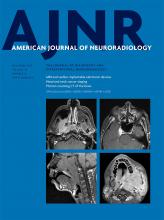Abstract
BACKGROUND: The safety and efficacy of flow-diversion treatment of MCA aneurysms have not been well-established.
PURPOSE: Our aim was to evaluate angiographic and clinical outcomes after flow diversions for MCA aneurysms.
DATA SOURCES: A systematic search of PubMed, MEDLINE, and Embase was performed for studies published from 2008 to May 2017.
STUDY SELECTION: According to Preferred Reporting Items for Systematic Reviews and Meta-Analyses guidelines, we selected studies with >5 patients describing angiographic and clinical outcomes after flow-diversion treatment of MCA aneurysms.
DATA ANALYSIS: Random-effects meta-analysis was used to pool the following outcomes: aneurysm occlusion rate, procedure-related complications, rupture rate of treated aneurysms, and occlusion of the jailed branches.
DATA SYNTHESIS: Twelve studies evaluating 244 MCA aneurysms were included in this meta-analysis. Complete/near-complete occlusion was obtained in 78.7% (95% CI, 67.8%–89.7%) of aneurysms. The rupture rate of treated aneurysms during follow-up was 0.4% per aneurysm-year. The rate of treatment-related complications was 20.7% (95% CI, 14%–27.5%), and approximately 10% of complications were permanent. The mortality rate was close to 2%. Nearly 10% (95% CI, 4.7%–15.5%) of jailed arteries were occluded during follow-up, whereas 26% (95% CI, 14.4%–37.6%) had slow flow. Rates of symptoms related to occlusion and slow flow were close to 5%.
LIMITATIONS: Small and retrospective series could affect the strength of the reported results.
CONCLUSIONS: Given the not negligible rate of treatment-related complications, flow diversion for MCA aneurysms should be considered an alternative treatment when traditional treatment methods are not feasible. However, when performed in this select treatment group, high rates of aneurysm occlusion and protection against re-rupture can be achieved.
ABBREVIATION:
- PRISMA
- Preferred Reporting Items for Systematic Reviews and Meta-Analyses
- © 2017 by American Journal of Neuroradiology












